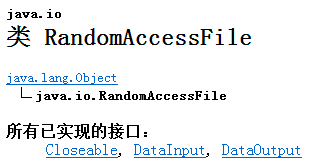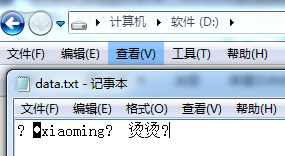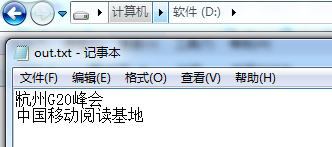一、简述

这个是JDK上的截图,我们可以看到它的父类是Object,没有继承字节流、字符流家族中任何一个类。并且它实现了DataInput、DataOutput这两个接口,也就意味着这个类既可以读也可以写。
二、存在的意义
1、是JAVA I/O流体系中功能最丰富的文件内容访问类,它提供了众多方法来访问文件内容。
2、由于可以自由访问文件的任意位置,所以如果需要访问文件的部分内容,RandomAccessFile将是更好的选择。
3、可以用来访问保存数据记录的文件,文件的记录的大小不必相同,但是其大小和位置必须是可知的。
这个类在很多资料上翻译成中文都是:随机访问文件,在中文里,随机是具有不确定的含义,指一会访问这里,一会访问那里的意思。如果以这种语义来解释的话,就会感到很困惑。其实,Random在英文中不仅仅有随机,还有任意的意思。如果中文名为任意访问文件是不是就会更好的理解。任意表示我们可以指定文件中任何一个位置去操作一个文件。
三、DEMO演示
(1)、写入文件
1 public class RandomAccessFileTest 2 { 3 public static void main(String[] args) throws IOException 4 { 5 RandomAccessFile raf = new RandomAccessFile("d:/data.txt","rw"); 6 Person p = new Person(1001,"xiaoming",1.80d); 7 p.write(raf); 8 } 9 } 10 class Person 11 { 12 int id; 13 String name; 14 double height; 15 public Person() 16 { 17 } 18 public Person(int id, String name, double height) 19 { 20 this.id = id; 21 this.name = name; 22 this.height = height; 23 } 24 25 public void write(RandomAccessFile raf) throws IOException 26 { 27 raf.write(id); 28 raf.writeUTF(name); 29 raf.writeDouble(height); 30 } 31 }
执行结果:

1、执行结果乱码是由于写入的是二进制文件,这个待会我们再使用程序读取。(这个跟前面介绍的DataInputStream、DataOutputStream类似)
2、第五行中,RandomAccessFile的构造函数除了指定了要写入了文件,还有另外一个参数:mod,主要用来指定打开文件的访问模式。

3、读取的方式就是读取基本数据类型,其中第28行使用的方法是:writeUTF(String str)
使用 modified UTF-8 编码以与机器无关的方式将一个字符串写入该文件,这个方法就是将字符串写入文件,而且不用担心会出现乱码,因为使用的编码方式是UTF-8
(2)、文件读取
由于刚才写入的是二进制文件,现在使用程序去读取文件:
1 public class RandomAccessFileTest 2 { 3 public static void main(String[] args) throws IOException 4 { 5 RandomAccessFile raf = new RandomAccessFile("d:/data.txt", "rw"); 6 Person p = new Person(1001, "xiaoming", 1.80d); 7 p.write(raf);// 写入文件后,任意访问文件的指针在文件的结尾 8 9 raf.seek(0);// 读取时,将指针重置到文件的开始位置。 10 Person p2 = new Person(); 11 p2.read(raf); 12 System.out.println("id=" + p2.getId() + ";name=" + p2.getName() 13 + ";height=" + p2.getHeight()); 14 15 } 16 } 17 class Person 18 { 19 int id; 20 String name; 21 double height; 22 public Person() 23 { 24 } 25 public Person(int id, String name, double height) 26 { 27 this.id = id; 28 this.name = name; 29 this.height = height; 30 } 31 32 public void write(RandomAccessFile raf) throws IOException 33 { 34 raf.writeInt(id); 35 raf.writeUTF(name); 36 raf.writeDouble(height); 37 } 38 39 public void read(RandomAccessFile raf) throws IOException 40 { 41 this.id = raf.readInt(); 42 this.name = raf.readUTF(); 43 this.height = raf.readDouble(); 44 } 45 public int getId() 46 { 47 return id; 48 } 49 public void setId(int id) 50 { 51 this.id = id; 52 } 53 public String getName() 54 { 55 return name; 56 } 57 public void setName(String name) 58 { 59 this.name = name; 60 } 61 public double getHeight() 62 { 63 return height; 64 } 65 public void setHeight(double height) 66 { 67 this.height = height; 68 } 69 70 }
执行结果:
id=1001;name=xiaoming;height=1.8
1、在39-43行代码中,由于是按基本数据类型写入和读取,所以在读取的时候一定严格按照写入的顺序。
2、第9行的位置上,由于在写入的时候,导致访问的指针的位置在文件的结尾处,现在读取的时候,需要将访问指针的位置重置到文件开头处。
(3)、追加内容
1 public static void main(String[] args) throws IOException 2 { 3 RandomAccessFile raf = new RandomAccessFile("D:/out.txt","rw"); 4 raf.seek(raf.length()); 5 raf.write(" 中国移动阅读基地".getBytes()); 6 }
执行结果:

1、这段程序演示了在文件原有内容的基础上去追加内容。其中seek方法就是将访问指针移动到文件内容的末尾。
2、RandomAccessFile依然只能追加,不能像文件的指定位置插入内容。如果强制将文件记录指针移动到中间位置后开始输出内容,则新的内容会覆盖文件中原有的内容。
3、如果需要向文件指定的位置插入内容,程序需要先把插入点后面的内容读入缓冲区,等插入完成后,再讲缓冲区的内容追加到文件的后面。
(4)、指定位置插入
1 public static void main(String[] args) 2 { 3 try 4 { 5 insert("d:/out.txt",5,"插入的内容"); 6 } 7 catch (IOException e) 8 { 9 e.printStackTrace(); 10 } 11 } 12 13 private static void insert(String fileName,long pos,String content) throws IOException 14 { 15 //创建临时空文件 16 File tempFile = File.createTempFile("temp",null); 17 //在虚拟机终止时,请求删除此抽象路径名表示的文件或目录 18 tempFile.deleteOnExit(); 19 FileOutputStream fos = new FileOutputStream(tempFile); 20 21 RandomAccessFile raf = new RandomAccessFile(fileName,"rw"); 22 raf.seek(pos); 23 byte[] buffer = new byte[4]; 24 int num = 0; 25 while(-1 != (num = raf.read(buffer))) 26 { 27 fos.write(buffer,0,num); 28 } 29 raf.seek(pos); 30 raf.write(content.getBytes()); 31 FileInputStream fis = new FileInputStream(tempFile); 32 while(-1 != (num = fis.read(buffer))) 33 { 34 raf.write(buffer,0,num); 35 } 36 }
执行结果:

1、这里插入内容的原理就是:先把插入点后面的内容读入缓冲区,等插入完成后,再讲缓冲区的内容追加到文件的后面。